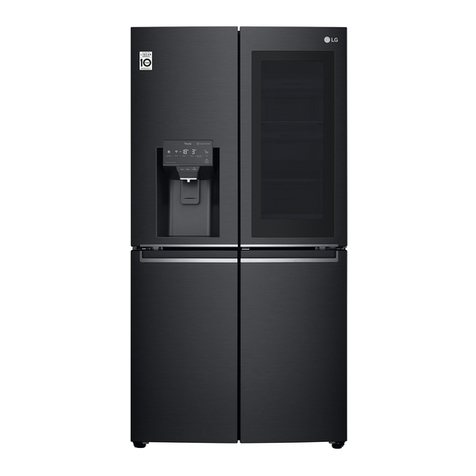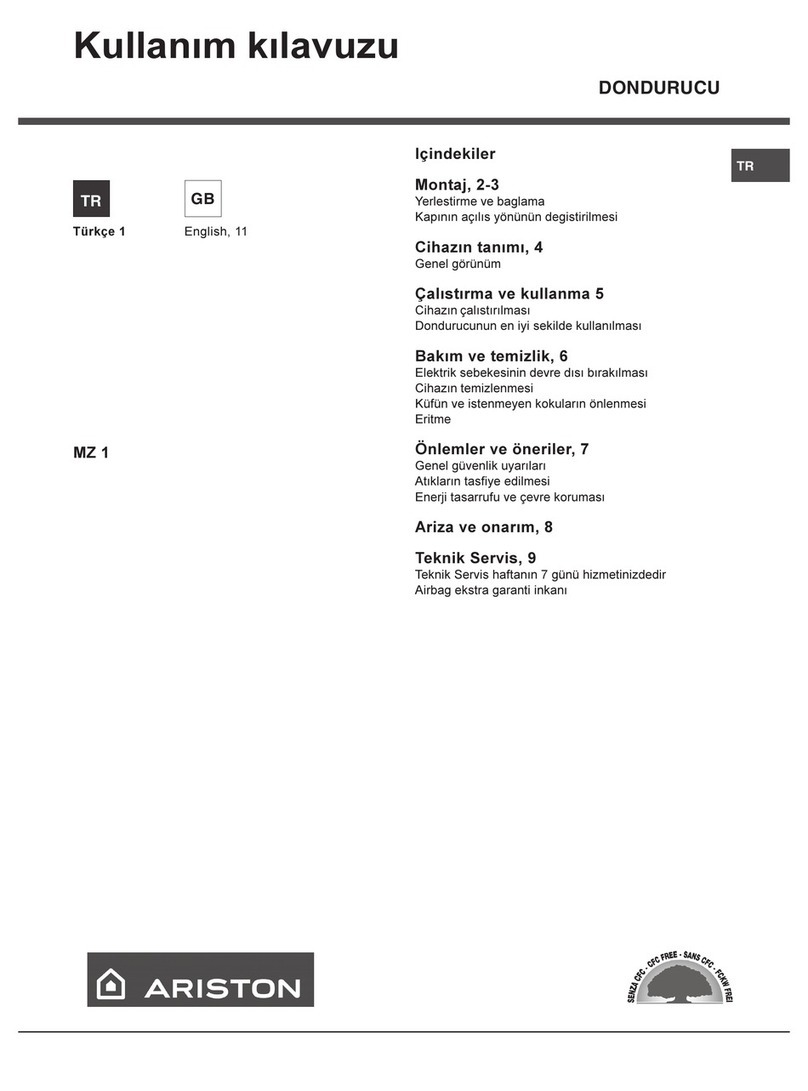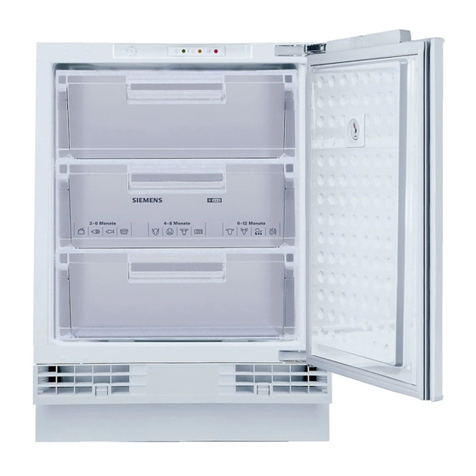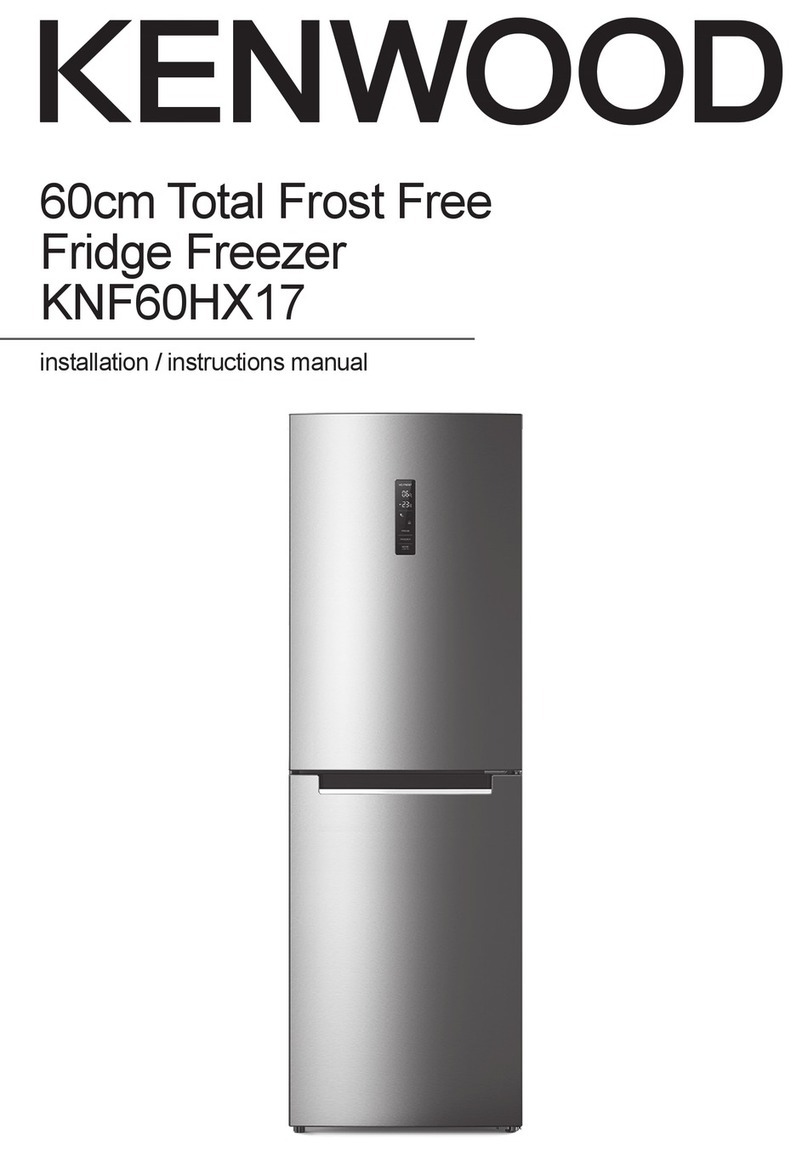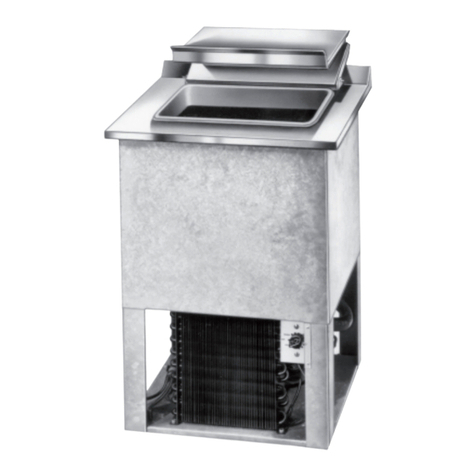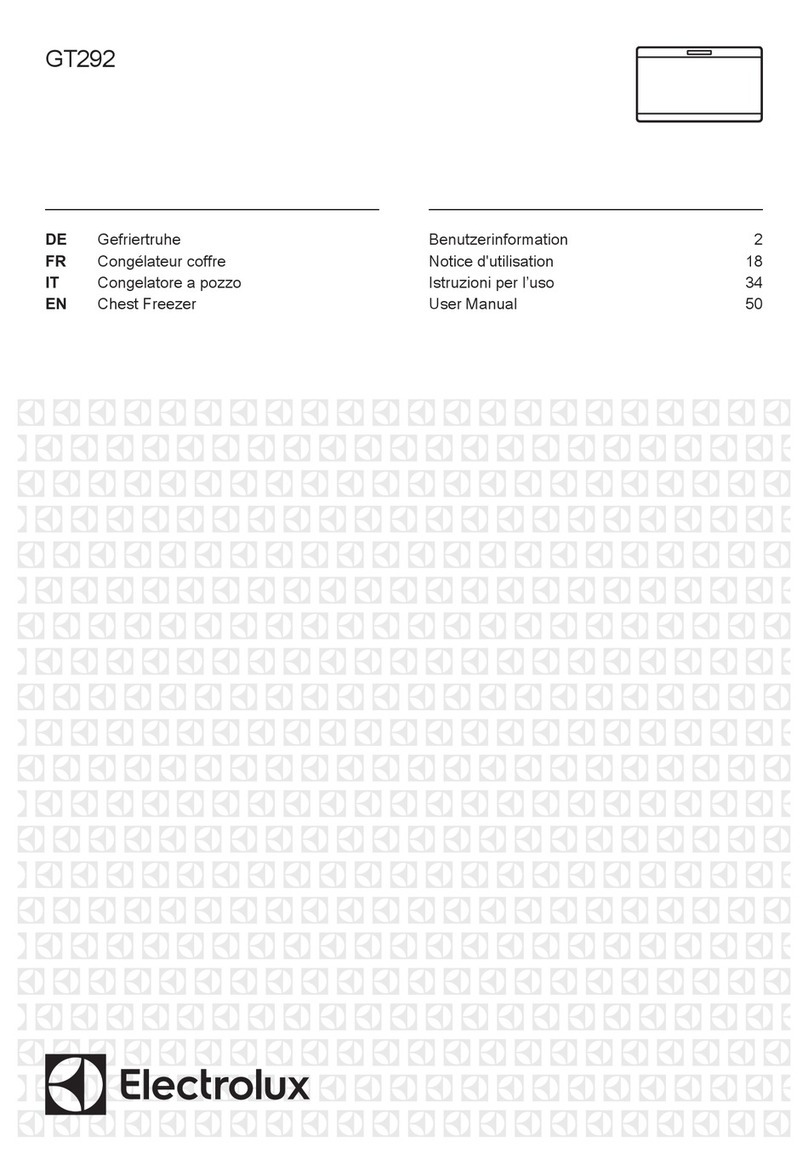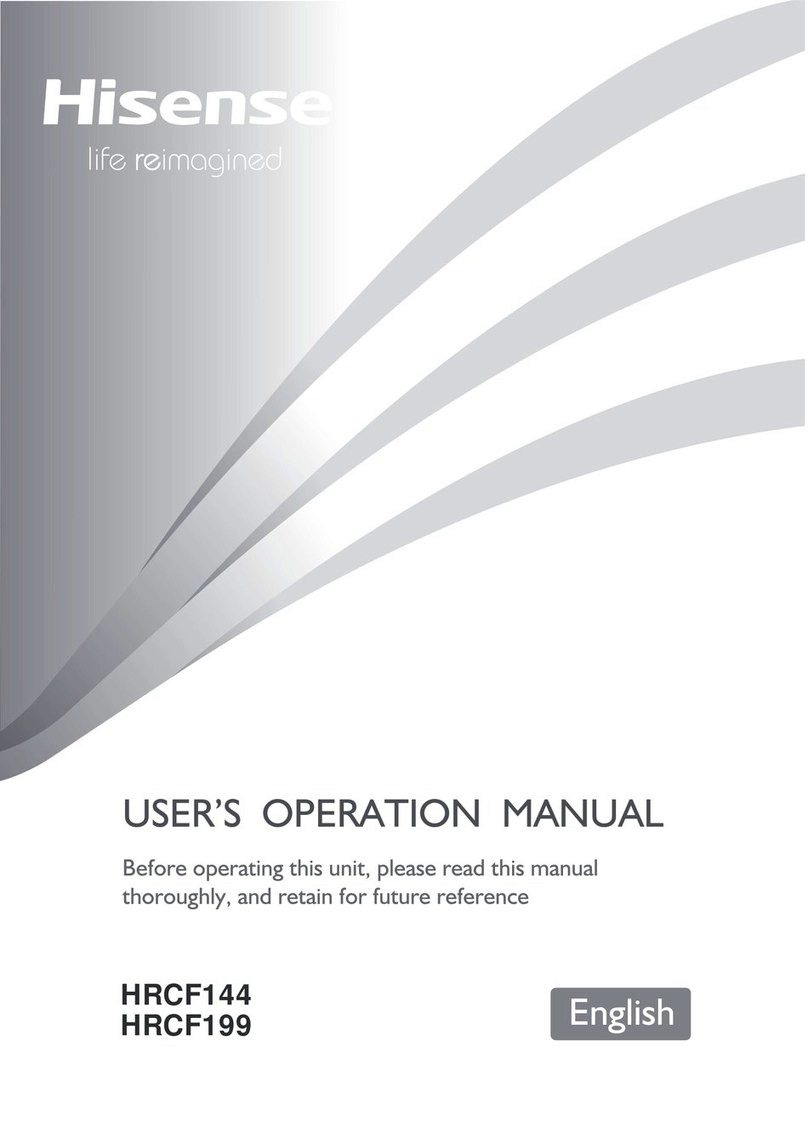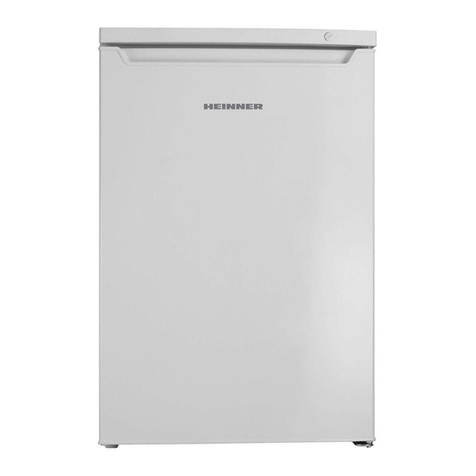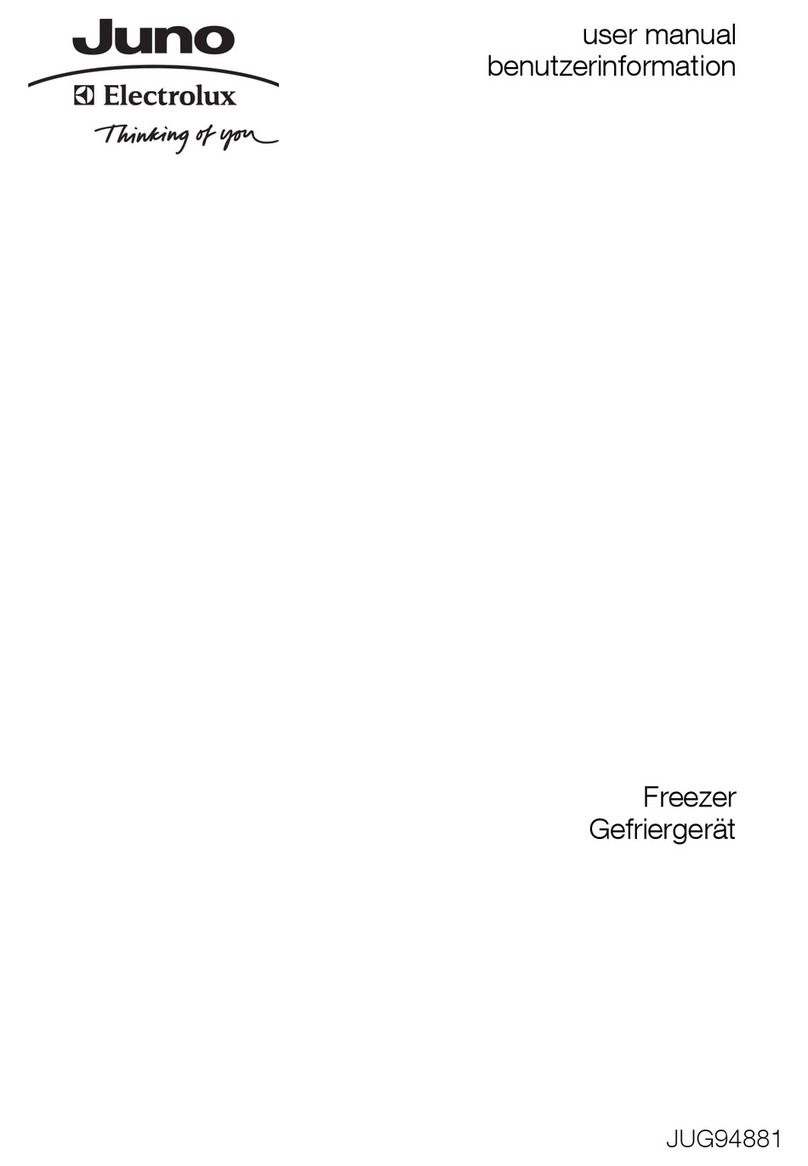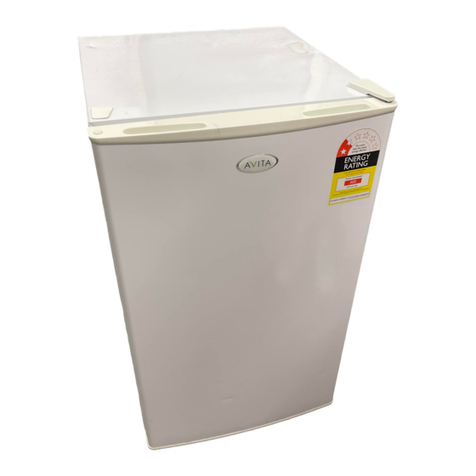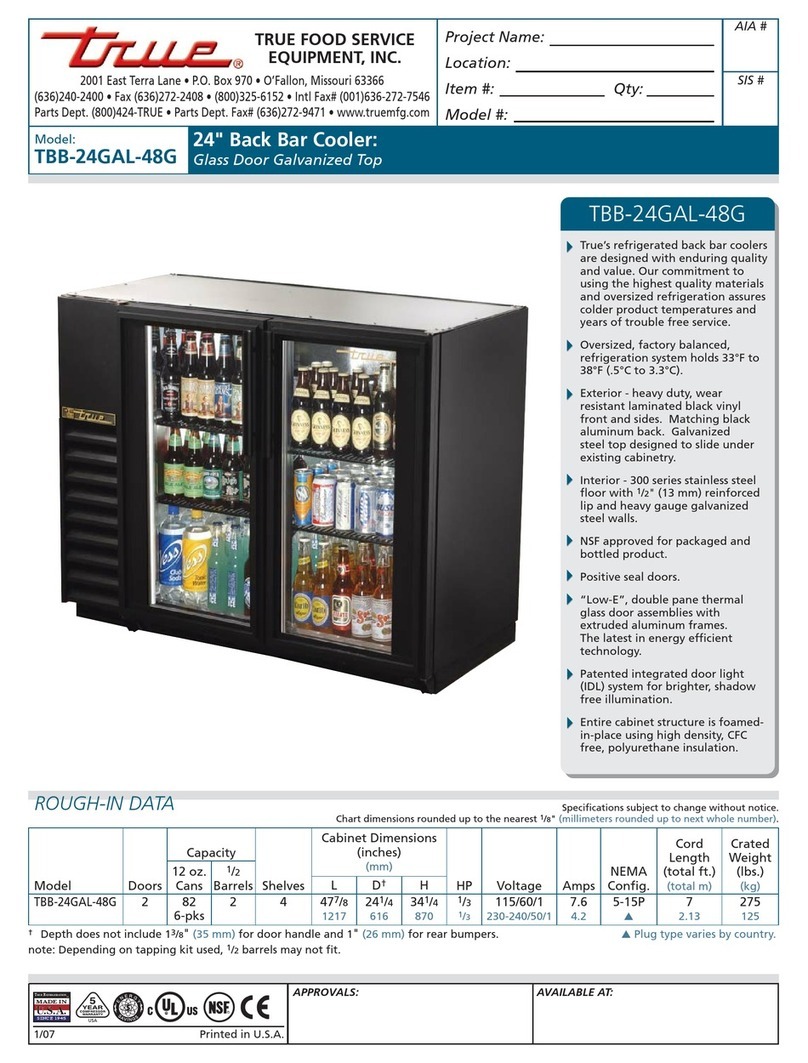Champion Marquis WC35 User manual

Circle the model of your cooler and
record the serial number below.
Read Carefully All Of This Manual
Before Installing The Unit.
Encierre con un circulo el modelo de su
enfriador y escribe el número de serie abajo.
Lea Con Cuidado Todo Este Manual Antes
De Instalar La Unidad.
Serial #
Número De Serie
Read And Save These Instructions
Evaporative Cooling
Evaporative cooling is nature’s way of cooling. When air is moved
over a wet surface, water is evaporated and heat is absorbed. When
stepping out of a swimming pool with the wind blowing, evaporative
cooling makes you feel cool, even though the air may be warm. The
human body itself is cooled primarily by the evaporation of
perspiration.
This unit works on the same principle. Air is drawn across wet
filter pads where the air is cooled by evaporation and then circulated
throughout the building. It is this combination of cooled air and the
movement of air over the skin which makes it feel cool.
Unlike refrigeration systems which recirculate the air, an evaporative
cooler continually brings in fresh air while exhausting old air. You
are completely replacing the air every 2 to 4 minutes by opening
windows or doors or a combination of both. The air is always fresh,
not stale, laden with smoke and odors as happens with refrigerated
air conditioning.
Vea el Español en el interior
110496-1 3-05www.championcooler.com
CHAMPION•MARQUIS
EVAPORATIVE COOLER
Models
WC 35 RWC35
WC 44 RWC46
WC 46 RWC50
WC 50
Safety Rules
1. Read these instructions carefully.
2. Electrical hook up should be done by a qualified electrician, so
that all electrical wiring will conform to your local standards.
3. Unit must be in the Off Position and Unplugged from power
receptacle when installing or performing any maintenance.
4. This cooler will run on 120 voltA.C., 60 Hz (cycle) current only.
5. Motor and pump are grounded and have an automatic thermal
overload switch which will shut motor off when it overheats.
The motor will restart automatically when it cools down.
6. Pump receptacle is for grounded evaporative cooler pump only.
Do not plug anything else into receptacle.
WARNING:To reduce the risk of fire or electric shock, do
not use this fan with any “solid-state fan speed control device.”

2110496-1
Cooler Installation
Installing House Legs
•NOTE: If installing unit without the use of the installation
kit, omit these directions and those pertaining to Fig. 3.
• Remove two corner screws in the bottom pan (A-Fig 2).
• Place the house leg bracket in the corner of the bottom pan, using
the two top holes in the bracket (B-
Fig 2). Replace the two previously
removed screws to hold the house
leg bracket in place (As shown by
dotted house leg bracket).
• Refer to the instructions “Adjust
house legs” below for adjusting the
house legs.
MountingCooler
CAUTION: Make sure that the mounting surface is strong
enough to support the operating weight of the cooler when in
use. (For operating weight, see Specification Table.)
CAUTION: Never plug in cooler until installation is com-
plete and unit has been tested for rigidity.
•Lift out all removable louvered sides.
•Screw chain hooks into window facing. Position the two chain
hooks above the neck of the cooler a distance equal to the width of
the cooler apart (A-Fig. 3). Hook one hanger chain in each hook and
then one “S” hook in the other end of each chain.
Operation
ManualControlUnits
•Pump setting. The rotary switch has 6 settings. The “Pump”
setting will operate the pump without the blower. For best results
turn the switch to “Pump” for a few minutes to wet the pads before
operating the fan.
•High and low cool settings. The “High Cool” and “Low Cool”
settings operate both the pump and the blower. Turn the unit to
“Low Cool” when possible. This lower speed allows the air to stay
longer in the wet pads and therefore increases it’s cooling efficiency.
•High and low vent settings. The “High Vent” and “Low Vent”
settings operate the blower without the pump. This is useful on
cool nights or at times when just a fan is desired.
RemoteControlUnits
These units may be controlled using the 3 buttons on the front panel
of the cooler or with the remote control.
• PUMP button. Pressing this button toggles the pump on and off.
When the LED is lit, the pump is running. For best results turn on
the pump for a few minutes to wet the pads before operating the
fan. The pump must be on while operating the fan for cooling. You
may also want the pump turned off at times when just a fan is
desired.
• FAN button. Pressing this button will cycle the fan through High
Speed / Low Speed / Off. The LED’s on the front of the control
indicate wether the fan is on high speed, low speed or off (no LED’s
lit). Note: There will be a 2 second delay between a button
press and the operation of the fan.
• ON/OFF button. Pressing this button while the pump or fan is on
will turn everything off. Pressing it again while in the off state will
return the fan and pump to their previous operating settings. When
first plugging in the cooler or after power has been interrupted,
pressing the On/Off button will start the cooler in the default state
which is with the pump on and the fan on high.
• Remote Control. To operate cooler with the remote you must be
within 20 feet and in sight of the cooler. Aim the remote at the front
panel. The buttons on the remote control have the same functions
as the buttons on the front panel of the cooler.
• Battery. The battery is shipped inside the remote with an insulator
between the battery and the contact. Before initial use, remove and
discard the insulator. To replace the battery, open the battery
compartment, pushing inward on the lock tab while pulling the
battery retainer outward from the remote (See Fig. 1). Place the
battery in the battery retainer, with the positive side up, and slide
the retainer into the remote.
The battery retainer should
slideinfreely-Donotforce
it.
NOTE: Dispose of the
used battery promptly.
Keepitawayfromchildren.
Do not disassemble and do
not dispose of in fire.
CAUTION: The battery used in this remote control may
present a risk of fire or chemical burn if mistreated. Do not
recharge, disassemble, heat above 212°F (100°C), or inciner-
ate. Replace the battery with the same type only - lithium
battery, Renata SA type CR2025, rated 3 volts. Use of another
battery may present a risk of fire or explosion.
Fig. 2
B
A
Push
Lock Tab
Inward
Pull
CR2025
Battery
Remote
Battery
Retainer
Fig. 1
OpenWindowsTo ExhaustAir
An often misunderstood concept of evaporative cooling is the amount
of air that should be exhausted. How much should you open your
windows? The fact is that most people do not open their windows
enough. The following method will help you determine the amount
to open your windows.
ChampionAirBalancingMethod
1. Take a piece of tissue paper and cut it lengthwise into 3 equal
strips.
2. Turn your cooler on High Cool.
3. Open one window at least six inches wide in each room that you
want to cool.
4. Take the piece of tissue paper and put it up against the screen of
the open window furthest from the cooler discharge opening. Let
go of it. It will do one of three things.
IF It falls down.
THEN CLOSE all of the windows one inch and try step 4 again.
IF It plasters itself to the screen.
THEN OPEN all of the windows one inch and try step 4 again.
IF It stays on the screen lightly.
THEN PERFECT. You are done. Enjoy your cooler.
Notes:
• When switching to Low Cool, you must rebalance your home.
Repeat step 4.
• Once you balance your home you can cool some areas more than
others by opening those windows more and closing the others by
the same amount. Repeat step 4 to make sure your home is still air
balanced.

3
110496-1
Fig. 4
Window Fill-In
Panels
Top Panel
Retainer
Bottom Panel
Retainer
NOTE: The chain hooks
supplied with this
mounting kit are for use
in wood. Additional an-
chors can be purchased at
your local hardware store
for anchoring in other
types of materials such as
concrete or brick.
•Install window panel
retainers. Place two
panel retainer strips onto
bottom of neck flange and
position to the width of
the window. Cut the
strips to fit if necessary.
These strips hold the win-
dow fill-in panels (Fig. 4).
•Position cooler in win-
dow. Position neck of
cooler so that bottom of
neck flange rests on win-
dow sill and flange (E-Fig.
3) is snug against edge of
sill (H-Fig. 2). With cooler
in position, hook the “S”
hooks into the holes of the top pan near the back of the cooler (B-
Fig. 3).
•Break fill-in panels to fit. With cooler installed, as described
above, measure for each window fill-in panel and score with sharp
knife and straight edge guide to desired width. To break window
fill-in panels, the panel should be laid over the edge of a straight flat
surface at the point to be broken off. Apply pressure on the edge of
the panel that extends over the edge of the surface and break off
unwanted piece.
•Install fill-in panels. Place one window fill-in panel on each side
of grill and into panel retainer strip at bottom of grill. Place the
other panel retainer strips onto top of neck flange and fill-in panels.
Be sure the panels are snug up against cooler neck.
•Place window behind retainer strip. Raise back of cooler so that
the window (D-Fig. 3) may be brought down behind top of panel
retainer strip (C-Fig. 3).
•Level Cooler. Adjust the chains to level the cooler.
•Adjust house legs. Pull out house legs so that the rubber bumpers
rest against house siding (F-Fig. 3). Tighten screw in retaining
collar. (G-Fig. 3).
A
B
C
D
E
FG
H
Window
Neck
“S” Hook
Fig. 3
Connecting Water
•Install overflow assembly. Remove nut and place nipple through
the hole in the pan, with the rubber washer between the pan and the
head of the drain nipple (Fig. 5).
Screw on nut and draw up tight
against bottom of pan. Insert over-
flow pipe in nipple to retain water.
Overflow pipe may be removed to
drain pan when necessary. A garden
hose may be screwed on the drain
nipple to drain water away from
your unit.
Maintenance
WARNING: Before doing any maintenance be sure power is
off and unit is unplugged. This is for your safety.
SpringStart-Up
•Oil bearings. The blower bearings and cooler motor in this unit
should be oiled with a few drops of non-detergent 20/30 weight oil
once each year. The motor does not need oil if it has no oil lines for
oiling. Motors that have no oil lines are lifetime oiled at the factory
and require no further oiling for the life of the unit.
CAUTION: Do not over oil. Over oiling can cause motor burn
out, due to excessive oil getting
into motor winding.
•Check belt tension. A 3 lb.
force should deflect the belt 3/
4 inches (see Fig. 8). Readjust
belt if needed.
•Clean pump. Cleaning the pump is necessary once a year at start-
up. For your safety, turn unit off and unplug from power receptacle.
Remove the pump from the mount slot. Remove the base of the
pump as shown in Fig. 9. Clean the pump and turn the impeller to
ensure free operation. Remove the pump spout and check for any
blockage. After cleaning,
reinstall the base onto the
pump. Reattach the pump
to the mount in the cooler
using the plastic retainer to
ensure that the pump will
not overturn. Do not for-
get to replace the spout and
water delivery tube onto
the pump outlet.
•Change Pads. Aspen pads should be replaced once or twice a
season, depending upon the length of the season. At the beginning
and at mid season a clean pad is more absorbent and efficient and
will deliver substantially more cool air.
Faucet
Water Supply
Valve
Sillcock
Ferrule
Nut
Fig. 6
Float Rod
Water Supply
Line
Washer
Nut
Ferrule
Nut
Fig. 7
Corner Post
Fig. 8
3 Lb.
3/4 Inches
Rubber Washer
Overflow Pipe
Nipple
Bottom Pan
Nut
Fig. 5
•Connect water supply line. Install a sillcock and water valve on
faucet as shown by figure 6. Place the nut and ferrule on the tubing
and tighten the nut until water tight.
•Install float valve. Install valve in the provided hole in corner post
(Fig. 7) and attach water supply line.
•Fill pan. Allow water to fill to within 1” of top of pan and adjust
float to maintain this water level. This can be accomplished by
bending the float rod (Fig. 7).
Depress Here To
Remove
Fig. 9

4110496-1
WinterShutDown
•Drain water. Always drain all of the water out of the cooler and
water supply line when not in use for prolonged periods, and par-
ticularly at the end of the season. Keep the water line disconnected
from both the unit and water supply so that it does not freeze.
•Cover unit. To protect the life of the finish, a cover for the unit is
suggested in extended periods of non use.
•Cover grill. To help keep out cold air you can use the optional
plastic grill cover. This cover may be purchased from your local
distributor. To install the cover, line up the grill cover with the grill
so that the tabs on the cover will slide over the center section of the
grill. Slide the grill cover onto the grill. The tabs will snap into
place. To remove, just pull the grill cover straight forward away
from the grill.
•Unplug unit from power supply during extended periods of
non-use.
Byfollowing the operating, installation,and maintenance suggestions
as outlined, you can get many years of efficient and satisfactory
servicefromyourcooler. In theeventadditionalinformationisdesired,
your dealer will be more than glad to assist you in every possible
way.
Vertical Duct Conversion
This window unit can be reconfigured to a vertical tunnel configura-
tion for installation into smaller width openings. Follow the
subsequent steps if this is desired.
1. Remove the 9 screws
from the sides and bot-
tom of the tunnel.
2. Remove the top 4
middle screws of the
top pan while holding
the tunnel in place (Fig
10). Be careful not to
drop the tunnel or
damage to the electric
cords could occur. You
may need to loosen
other screws in the top
pan to make it easier to remove the tunnel.
3. Rotate the tunnel 90 degrees counter-clockwise (Fig 11). Be
careful as you rotate the tunnel that you don’t damage or discon-
Fig. 11
Fig. 12
Line up to the two
middle holes
nect the cords which are still con-
nected to the controls and the
front panel.
4. Insert the flange of the tunnel
between the front panel and the
top pan. Line up the two larger
holes in the tunnel with the cen-
ter two holes of the top pan. (Fig
12).
5. Using the screws taken from the
top pan, secure the tunnel to the
unit. Do not tighten the screws,
leave them loose until the
rest of the tunnel has been
secured.
6. Line up the three holes at
the bottom of the tunnel
with the holes in the front
panel. Using the screws
taken from the bottom of
the tunnel previously, se-
cure the tunnel to the front
panel.
7. Make sure all the screws
removed from the top pan
are in place and tighten all
screws.
8. Remove the three screws (2 in
model (R)WC35) from each side
of the front panel as shown in fig-
ure 13. CAUTION: Make
sure that you do not remove the
bottom most screw. It holds the
blower housing in place.
9. In the installation kit there are two
strips of metal that will cover the
gap in the front panel. Line up the
holes in the metal strips to the
holes in the front panel and secure
them with the screws previously removed in step 8. (See Fig.
13) Install the metal strips so that there is no gap between the
top pan and the metal strip. If there is a gap, turn the metal strip
around.
NOTE: When mounting a cooler with this type of vertical
tunnel configuration, the unit should be supported by a flat
support or stand. The installation method mentioned in the
owner’s manual using chains and legs should not be used. The
filler panels in the installation kit may be used to seal off the
window above the cooler duct.
Fig. 10
Remove top
screws last. Do
Not Drop Tunnel
Wiring Diagrams
Hi
Low
Gnd
Com.
Black
Red
Green
White
Plug Switch
Blower Motor
Pump
Motor
ManualControl
Hi
Low
Gnd
Com.
Black
Red
Green
White
Ground
Wire
Blower Motor
Pump
Motor
LockPlate
w/Grommet
RemoteControl
Control
Ground
Screw
Fig. 13
Do Not Remove
Bottom Screw
Metal
Strip

5
110496-1
Limited Warranty
This warranty is extended to the original purchaser of an evaporative cooler installed and used under normal conditions. It does not cover
damages incurred through accident, neglect, or abuse by the owner. We do not authorize any person or representative to assume for us any
other or different liability in connection with this product.
TermsAndConditionsOfTheWarranty
For Eight Years from date of purchase, we will replace the original base assembly if water leakage should occur due to rust out.
For One Year from date of purchase, we will replace any original component provided by Champion Cooler which fails due to any defect in
material or factory workmanship only.
ExclusionsFromTheWarranty
We are not responsible for replacement of cooler pads. These are disposable components and should be replaced periodically. We are not
responsible for any incidental or consequential damage resulting from any malfunction.
We are not responsible for any damage received from the use of water softeners, chemicals, descale material, plastic wrap, or if a motor of a
higher horsepower than what is shown on the serial plate is used in the unit.
We are not responsible for the cost of service calls to diagnose cause of trouble, or labor charge to repair and/or replace parts.
HowToObtainService UnderThisWarranty
Contact the Dealer where you purchased the evaporative cooler. If for any reason you are not satisfied with the response from the dealer,
contact the Customer Service Department: Champion Cooler, 5800 Murray Street, Little Rock, Arkansas 72209. 1-800-643-8341.
info@championcooler.com.
This limited warranty applies to the original purchaser only.
Problem Possible Cause Remedy
Failure to
start or no
air delivery
Inadequate
air delivery
with cooler
running
Inadequate
cooling
1. No electrical power
to unit
• Fuse blown
• Circuit breaker
tripped
• Electric cord
unplugged or
damaged
2. Belt too loose or
tight
3. Motor overheated
• Belt too tight
• Blower bearings
dry
4. Motor locked
1. Insufficient air
exhaust
2. Belt too loose
3. Pads plugged
1. Inadequate exhaust in
house
2. Pads not wet
• Pads plugged
• Open spots in pads
• Trough holes
clogged
• Pump not working
properly
1. Check power
• Replace fuse
• Reset breaker
• Plug in cords or
replace if
damaged
2. Adjust belt tension
3. Determine cause of
overheating
• Adjust belt
tension
• Oil blower
bearings
4. Replace motor
1. Open windows or
doors to increase air
flow
2. Adjust belt tension
or replace if needed
3. Replace pads
1. Open windows or
doors to increase air
flow
2. Check water
distribution system
• Replace pads
• Repack pads
• Clean trough and
unplug holes
• Replace or clean
pump (Unplug
unit)
Troubleshooting
Motor
cycles on
and off
Noisy
Excessive
humidity in
house
Musty or
unpleasant
odor
Water
draining
from cooler
1. Low voltage
2. Excessive belt
tension
3. Blower shaft tight or
locked
4. Bearings dry
1. Bearings dry
2. Wheel rubbing
blower housing
3. Loose parts
1. Inadequate exhaust
1. Stale or stagnate
water in cooler
2. Pads mildewed or
clogged
3. Pads not wetting
properly
• Trough holes
clogged
• Pump not
working properly
1. Float arm not
adjusted properly
2. Overflow assembly
leaking
1. Check voltage
2. Adjust belt tension
3. Oil or replace
bearings (Unplug
unit)
4. Oil bearings
1. Oil bearings
2. Inspect and realign
(Unplug unit)
3. Tighten loose parts
1. Open doors or
windows
1. Drain pan and
clean pads
2. Replace pads
3. Check water
distribution system
• Clean
• Replace or clean
pump (Unplug
unit)
1. Adjust float
2. Tighten nut and
overflow pipe.
Problem Possible Cause Remedy

6110496-1
Parts Drawing / Dibujo De Piezas
Motor Specifications / Especificaciones Del Motor
Model No.
Modelo Motor Part #
Motor - N° HP
HP Speed
Velocidad Volts
Voltios Motor Pulley Part #
Polea Del Motor - N° Electrical Cord Part #
Cable Eléctrico - N° Drive Belt Part #
Banda - N°
WC35, RWC35 110445 1/3 2 115 110271 110364 110211 (4L-450)
WC44 110445 1/3 2 115 110272 110364 110215 (4L-560)
WC46, RWC46 110445 1/3 2 115 110272 110372 110215 (4L-560)
WC50, RWC50 110447 1/2 2 115 110273 110372 110215 (4L-560)
General Specifications / Especificaciones Generales
Model No.
Modelo
Weight (lbs.)
Peso (libras) Cabinet Dimensions (in.)
Dimensiones De La Caja (pulgadas) Window Opening Req'd (in.)
Abertura Requerida (pulgadas)
Dry
Seco Operating
Lleno Height
Altura Width
Anchura Depth
Profundidad Width
Anchura Height
Altura
WC35, RWC35 125 202 33 7/16 28 1/8 28 1/8 21 3/4 14 3/4
WC44 137 214 34 1/2 34 1/8 28 1/2 21 3/4 14 3/4
WC46, RWC46 152 246 34 1/2 34 1/8 34 1/8 21 3/4 14 3/4
WC50, RWC50 155 249 34 1/2 34 1/8 34 1/8 21 3/4 14 3/4
2
28
27
25
35
20
22
13
14
16
19
15
31
8
12
34
33
30
3
11 26
43
39
38
38
46
21
1
36
37
40
39
4142
5
3
64
10
18
7
24
23
29
9
44
Models: WC35,44,46,50
Models: RWC35,46,50
48 49
17
Optional Accessories
51
52
50
45
47
53

7
110496-1
No. WC35 WC46, RWC46
N° Description / Descripción RWC35 WC44 WC50, RWC50
1. Top Pan / Tapa ........................................................................................................... 222903-001 222905-001 220901-003
2. Bottom Pan / Base De La Caja ................................................................................. 222904-001 222903-005 220902-001
3. Louvered Side / Reja Lateral...................................................................................... 224006-003 224006-006 224007-005
4. Louvered Back / Reja Posterior................................................................................. 224006-003 224007-005 224007-005
5. Water Trough, Side / Canal De Agua, Lateral .......................................................... 226003-001 226003-001 226003-002
6. Water Trough, Back / Canal De Agua, Posterior ..................................................... 226003-001 226003-002 226003-002
7. Aspen Pads, Side / Filtros De Paja, Lateral ............................................................ 110091 110094 110098
8. Aspen Pads, Back / Filtros De Paja, Posterior ....................................................... 110091 110098 110098
9. Pad Retainer, Side / Soporte Para El Filtro, Lateral ................................................ 3PW-3 3PW-3 3PW-5
10. Pad Retainer, Back / Soporte Para El Filtro, Posterior ........................................... 3PW-3 3PW-5 3PW-5
11. Corner Post, With Float Hole / Poste De Esquina, Con Agujero Para Flotador ..... 224003-022 224003-032 224003-032
12. Corner Post, No Float Hole / Poste De Esquina, Sin Agujero Para Flotador .......... 224003-002 224003-033 224003-033
13. Front Panel / Panel Delantero ................................................................................... 224106-007 224103-006 224105-004
14. Tunnel / Túnel (Cuello Del Enfriador) ..................................................................... 322120-001 322120-001 322120-001
15. Blower Housing / Caja De La Rueda ....................................................................... 324104-009 324103-007 324105-006
16. Blower Wheel / Rueda................................................................................................ 12BW 15BW 16BW
17. Shaft, Blower Wheel / Eje De La Rueda ................................................................... 110182 110182 110183
18. Bearings, Blower Wheel Shaft / Cojinetes Del Eje De La Rueda ............................ 110351 110351 110351
19. Pulley, Blower Wheel / Polea De La Rueda ............................................................. 110274 110275 110275
20. Drive Belt / Correa .................................................................................................... 110211 110215 110215
21. Motor / Motor ............................................................................................................ 110445* 110445* *
22. Pulley, Motor / Polea Del Motor .............................................................................. 110271 110272 *
23. Motor Mount / Montura Del Motor......................................................................... 314003-001 314003-025 314003-024
24. Motor Mount Clips / Seguros Para Montar Motor................................................ 314005-001 314005-001 314005-001
25. Float Valve / Válvula Del Flotador ........................................................................... FL-C FL-C FL-C
26. Pump Mount / Montura De La Bomba .................................................................... 216003-001 216003-001 216003-001
27. Pump Screen / Malla Para La Bomba ...................................................................... 281001-001 281001-001 281001-001
28. Pump Assembly / Bomba .......................................................................................... C60P-120 C60P-120 C60P-120
29. Pump Retainer / Sujetador De La Bomba................................................................. 110866N 110866N 110866N
30. Connector, Pump Mount / Unión Para La Montura De La Bomba ...................... 3PM-1 3PM-1 3PM-1
31. Tube, Water Delivery / Tubo De Agua ..................................................................... 310716 310716 310716
33. Water Distributor Assembly / Sistema Del Distribuidor De Agua ......................... 3D-2 3D-3 3D-10
34. Holder, Water Distributor / Soporte Para El Distribuidor De Agua ...................... 110574 110574 110574
35. Over Flow Assembly / Montaje De Desagüe ........................................................... 3OA-1 3OA-1 3OA-1
36. House Leg Collar / Collar De La Pata...................................................................... 3HL-1 3HL-1 3HL-1
37. House Leg / Pata ........................................................................................................ 310811 310811 310811
38. Retainers, Window Panels / Guarda De Retención Para Los Paneles ................... 110599 110599 110599
39. Window Panels / Paneles De Relleno Para La Ventana ........................................... 110603 110603 110603
40. †Electrical Cord, Motor / Cable Eléctrico Del Motor .............................................. 110364† 110364 110372†
41. †Wiring Harness / Cableado Eléctrico ...................................................................... 110375† 110375 110375†
42. †Switch / Interruptor ................................................................................................. 110425† 110425 110425†
43. †Knob, Switch / Perilla Del Interruptor................................................................... 110839-006† 110839-006 110839-006†
44. †Switch Box / Caja Para El Interruptor ..................................................................... 222006-001† 222006-001 222006-001†
45. †Lockplate, Manual Units / Placa De fijación, Unidades De Control Manual....... 222007-001† 222007-001 222007-001†
46. †Grill Assembly, Maunual Units / Rejilla Completa, Control Manual ................... 110839-1† 110839-1 110839-1†
46a. ‡Grill Assembly, Remote Units / Rejilla Completa, Control A Distancia .............. 110839-2‡ - 110839-2‡
47. ‡Lockplate & Grommet, Remote Units / Placa De fijación Con Pasahilo, Control A Distancia .......322007-004‡ - 322007-004‡
48. ‡Electronic Control Assembly / Montaje De Control Electrónico ........................... 110400‡ - 110400‡
49. ‡Dress Ring / Anillo Decorativo................................................................................. 110403‡ - 110403‡
50. ‡Remote Control / Mando A Distancia ..................................................................... 110401‡ - 110401‡
51. **Grill Cover / Cubierta Para La Rejilla .................................................................. 110829** 110829** 110829**
52. **Bleed-Off Kit / Equipo De La Válvula De Desahogo ......................................... 310586** 310586** 310586**
53. Mount Strip For Vertical Tunnel / Tira De Metal Para El Conducto Vertical ....... 222008-001 222008-001 222008-001
* See motor specification table. / Vea la tabla de especificaciones del motor.
** Optional accessories. Must be purchased separately. / Accesorios opcionales. Debe comprarlos por separados.
† For Manual Control units - Models WC35,44,46 & 50. / Para las unidades de control manual - Modelos WC35,44,46 y 50.
‡ For Remote Control units - Models RWC35,46 & 50. / Para las unidades de control a distancia - Modelos RWC35,46 y 50.
NOTE: Standard hardware items may be purchased from your local hardware store.
NOTA: Artículos de uso corriente pueden comprarse en la ferretería de su localidad.
Replacement Parts List / Lista De Piezas De Repuesto
When ordering parts, please be sure to furnish the following information on all orders. Failure to do so may delay your order. /
Al pedir piezas, incluya toda la información siguiente con su pedido. El no proporcionar toda esta información resultará en una demora.
1. Cooler serial number / Número de serie de la unidad
2. Description and part number / Descripción y número de pieza
3. Cooler size / Tamaño de la unidad
4. Date of purchase / Fecha de compra

8110496-1
Lea y Conserve Estas Instrucciones
Reglas De Seguridad
1. Lea las instrucciones con cuidado.
2. Las conexiones eléctricas deben ser hechas por un electricista
competente, para que todo el cableado eléctrico cumpla con los
requisitos establecidos en su localidad.
3. La unidad debe estar Apagada y Desconectada de la electricidad
cuando se instale o haga cualquier mantenimiento.
4. Su enfriador funciona sólo con corriente alterna de 120 voltios,
60 Hz. (ciclos).
5. El motor y la bomba están conectados con la tierra, y se apagarán
automáticamente en caso de sobrecalentamiento. Los motores
volverán a funcionar cuando se enfrían.
6. Enchufe una bomba del enfriador evaporativo solamente y nada
más al receptáculo de la bomba.
ADVERTENCIA: Para reducir el riesgo de incendio o
toques eléctricos, no use este ventilador con ningún “dispositi-
vo de estado sólido para controlar la velocidad del ventilador.”
Enfriamiento Por Evaporación
El enfriamiento por medio de evaporación es la manera de la natura-
leza de refrescarse. Cuando el aire se mueve sobre una superficie
mojada, se evapora el agua y se absorbe el calor. Al salir de una
piscina con el viento que sopla usted se siente fresco, aunque el aire
puede ser caliente. El cuerpo humano sí mismo es refrescado prin-
cipalmente por la evaporación del sudor.
Este enfriador funciona usando el mismo principio. El aire se traza
a través de los filtros mojados donde el aire se enfría por medio de
evaporación y después circula a través del edificio. Se hace frío de la
sensación cuando tiene esta combinación del aire enfriado y del
movimiento del aire sobre la piel.
A diferencia de los acondicionadores de aire que recirculan el aire, un
enfriador evaporativo trae continuamente por dentro el aire fresco
mientras agota el aire viejo. Se reemplaza completamente el aire
cada 2 a 4 minutos, abriendo las ventanas o las puertas o una combi-
nación de ambas. El aire es siempre fresco, no es viciado, cargado de
humo y olores como ocurre con los sistemas de aire acondicionado a
base de refrigeración.
•Los posiciones HIGH COOL y LOW COOL. Ajuste el inte-
rruptor a la posición HIGH COOL o LOW COOL para poner en
marcha el ventilador a una alta o baja velocidad junto con la bomba.
Ajuste el interruptor a la posición LOW COOL cuando posible.
Esta baja velocidad del ventilador permite que el aire se queda más
de largo en los filtros mojados y de tal modo produce un aire más
fresco.
•Los posiciones HIGH VENT y LOWVENT. Ajuste el interrup-
tor a la posición HIGH VENT (alta) o LOW VENT (baja) para
poner en marcha el ventilador a una alta o baja velocidad sin la
bomba. Este es útil en noches frescas o cuando se desea un venti-
lador solamente.
ParaLas UnidadesDe ControlADistancia
Estas unidades pueden ser controladas con los tres botones en la
rejilla por delante del enfriador o con el mando a distancia.
• El Botón PUMP. Al presionar este botón pondrá en marcha y
apagará la bomba. Cuando está iluminada la luz LED, la bomba
está en marcha. Para mejor resultado ponga en marcha la bomba
por unos cuantos minutos para mojar los filtros antes de poner en
marcha el ventilador. Para tener aire fresco, debe poner en marcha
la bomba mientras el ventilador está en marcha. Se puede apagar la
bomba cuando se desea un ventilador solamente.
• El Botón FAN. Este botón controla el ventilador. Al presionar
este botón cuando el ventilador está apagado pondrá en marcha el
ventilador a alta velocidad. La segunda prensa pondrá en marcha a
baja velocidad, y la prensa siguiente apagará el ventilador. Hay
luces LED por el frente del control que indica en cual estado esté el
ventilador - alta velocidad, baja velocidad, o apagado (ninguna luz
LED iluminada). Nota: Habrá un retardo de dos segundos
entre una prensa del botón y la operación del ventilador.
• El Botón ON/OFF. Al presionar este botón mientras está encen-
dido el ventilador o la bomba apagará todo. Al presionarlo otra vez
mientras este apagado volverá el ventilador y la bomba a sus esta-
dos de funcionamiento anteriores. Cuando primero enchufe el
enfriador o después de que la electricidad se haya interrumpido,
presionando el botón On/Off encenderá el enfriador a su estado
por defecto lo cual está con la bomba encendido y el ventilador en
el estado de alta velocidad.
• El Mando ADistancia. Al funcionar el enfriador con el mando a
distancia, debe estar no más de 20 pesados a distancia y en la vista
del enfriador. Apunte el mando a distancia al frente del enfriador.
Los botones del mando a distancia tiene las mismas funciones que
los botones en el frente del enfriador.
• La Batería. La batería se envía dentro del mando a distancia con
un aislador entre la batería y el contacto. Al principio, antes de
funcionar el mando a distancia, quite y deseche el aislador. Al
reemplazar la batería, abra el compartimiento de la batería empu-
jando la lengüeta de soltar y tirando al mismo tiempo el retenedor
de la batería hacia fuera del mando a distancia (véase la figura 1).
Coloque la batería en el
retenedor de la batería,
con el lado positivo
para arriba, y resbale el
retenedor dentro del
mando a distancia. El
retenedor de la batería
deberesbalaradentro li-
bremente-Nolofuerce.
Operación
ParaLas Unidades DeControl Manual
•La posición PUMP. El interruptor tiene seis posiciones. Ajuste
el interruptor a la posición PUMP (bomba) para poner en marcha
la bomba sin el ventilador. Para mejor resultado ponga en marcha
la bomba por unos cuantos minutos para mojar los filtros antes de
poner en marcha el ventilador. Empujar
Lengüeta
De Soltar
Quitar
CR2025
Batería
Mando A
Distancia
Retenedor
De La
Batería
Fig. 1

9
110496-1
InstalarElEnfriador
PRECAUCION: La superficie en que ha de colocarse el
enfriador deberá aguantar el peso completo de la unidad cuan-
do ésta está en funcionamiento. (Para saber este peso, vea la
tabla de especificaciones.)
PRECAUCION: No conecte el enfriador hasta que la ins-
talación esté completa y se haya comprobado la estabilidad del
mismo.
•Quite todas las rejas de los costados.
•Fije los ganchos en la pared. Ponga los dos ganchos para la
cadena arriba del cuello del enfriador, separados por una distancia
equivalente al ancho de la
unidad (A-fig. 3). Engan-
che una cadena en cada
gancho y luego enganche
un gancho “S” en cada ca-
dena. NOTA: Losganchos
que vienen con ésta unidad
tienen rosca de tornillo
para madera y son para uso
en paredes de madera. Las
paredes de concreto o la-
drillo requieren el uso de
tuercas mariposas de sufi-
ciente fuerza o anclas con
ganchos de acoplamientos.
•Instale las guardas
de retención. Colo-
que dos guardas de
retención en la parte
inferior de la pestaña
del cuello y ajústelas
al ancho de la venta-
na. Corte las guardas
si es necessario. És-
tas sujetan a los
panelesderelleno(fig.
4).
•Coloque el enfriador en la ventana. Coloque el cuello del
enfriador dentro de la ventana para que la parte inferior de la
pestaña del cuello se asiente en la repisa de la ventana y la pestaña
(E-fig. 3) se ajuste contra el borde de la repisa (H-fig. 3). Con la
unidad situado en la ventana, enganche los ganchos “S” en los
agujeros encontrado en la esquina trasera superior del enfriador
(B-fig. 3).
•Rompa los paneles de relleno. Con el enfriador instalado según
el método de arriba, mida el ancho requerido para cada panel.
Marque el panel con un cuchillo filoso y una regla al ancho correc-
to. Apoye el panel en el borde de una superficie lisa y plana y
presione sobre la parte del panel que se extienda sobre el borde de
la superficie, para que se desprenda la parte sobrante.
•Instale los paneles de relleno. Coloque un panel de relleno a
cada lado de la rejilla y dentro de la banda de retención situada en
la parte inferior de la rejilla. Coloque las otras guardas de retención
en la parte superior de la pestaña del cuello y los paneles de
relleno. Compruebe que los paneles queden bien ajustados contra
el cuello.
Instalación
InstalarLas Patas
•NOTA: Si instale la unidad sin el uso del equipo de instala-
ción, omite las direcciones siguientes y las de la figura 3.
• Quite los tornillos de la esquina de
la bandeja (A-fig. 2).
• Coloque la ménsula en la esquina de
la bandeja usando los dos agujeros
de la parte superior de la ménsula
(B-fig. 2) y los dos tornillos que an-
tes había quitado.
• Coloque la ménsula del otro lado de
la misma manera.
• Vea la instrucción abajo de “Ajuste
las patas” para ajustar las patas.
Guarda De
Retención
Superior
Fig. 4
Paneles De
Relleno
Guarda De
Retención Inferior
A
B
C
D
E
FG
H
Cuello
Gancho “S”
Fig. 3
Fig. 2
B
A
NOTA: Disponga la batería vieja puntualmente. Manténgala a
distancia de los niños. No la desmonte y no la disponga en fuego.
PRECAUCION: La batería usada en este mando a distan-
cia puede presentar un riesgo del fuego o de la quemadura
química si la maltrate. No la recargue, no la desmonte, no la
caliente más de 212°F (100°C), ni incinérela. Reemplace la
batería por el mismo tipo solamente - batería de litio, tipo
CR2025 de Renata SA, 3 voltios. El uso de otra batería puede
presentar un riesgo del fuego o de la explosión.
¿Cuanto Debe Abrir Las Ventanas?
Un concepto a menudo entendido mal de enfriamiento por evapora-
ción es la cantidad de aire que debe ser agotada. Cuánto debe usted
abrir sus ventanas? El hecho es que la mayoría de la gente no abre
sus ventanas bastante. El método siguiente le ayudará.
ElMétodoDe Champion DeEquilibrarElAire
1. Tome un pedazo de papel de seda y córtelo a lo largo en 3 tiras
iguales.
2. Ponga en marcha a su enfriador a “High Cool”.
3. Abra una ventana por lo menos seis pulgadas de ancho en cada
sitio que usted desee refrescar.
4. Tome un pedazo de papel de seda y póngalo contra la pantalla de
la ventana abierta más lejos de la apertura del enfriador. Suéltalo
al papel de seda. Hará una de tres cosas:
SI: Se caiga.
ENTONCES: CIERRE todas las ventanas una pulgada e intente
el paso 4 otra vez.
SI: Se queda contra la pantalla con fuerza.
ENTONCES: ABRA todas las ventanas una pulgada e intente el
paso 4 otra vez.
SI: Se queda ligeramente contra la pantalla.
ENTONCES: PERFECTO. Se ha acabado. Goce del aire refres-
cante.
NOTAS:
• Al poner el enfriador a “Low Cool”, usted debe reequilibrar el aire
de su hogar. Repita el paso 4.
• Al equilibrar el aire de su hogar usted puede refrescar algunas áreas
más que otras abriendo esas ventanas más y cerrando las otras por
la misma cantidad. Repita el paso 4. Asegurarse de que el aire de
su hogar sea equilibrado.

10 110496-1
Fig. 9
3 Libras
3/4 Pulgadas
Mantenimiento
ADVERTENCIA: Antes de hacer cualquier mantenimien-
to, compruebe que la unidad esté apagada y desconectada de la
electricidad. Esto es por su seguridad.
PuestaEnMarchaEnLa Primavera
•Cambie los filtros. Debe cambiar los filtros de paja una o dos
veces durante cada temporada, según la duración de ésta. Al prin-
cipio y a mediados de la temporada, un filtro limpio es más
absorbente y eficiente y producirá un mayor volumen de aire frío.
Apriete Aqui
Para Quitar
Fig. 8
•Limpie la bomba. Es necesario limpiar la bomba una vez al
principio de cada año. Por su propia seguridad, apague la unidad
y desconéctela de la electricidad. Quite el sujetador de plástico de
la montura y jale la bomba, deslizándola hacia usted. Quite la
parte de abajo según se muestra en la figura 8. Limpie la bomba.
Dé le vuelta a la hélice para verificar que se mueve libremente.
Quite el pico de la bomba y vea si está obstruido. Vuelva a colocar
la bomba en la unidad y fí-
jela en su montura con el
sujetador de plástico.
Esto impedirá que se caiga
labombaalagua,loqueda-
ñaría el motor. No se
olvide de volver a conectar
el tubo de agua a la bomba.
La bomba contiene protec-
ción en caso de
sobrecalentamiento (se
apagaráautomáticamente).
•Lubrique los cojinetes. Los cojinetes de la rueda y el motor del
ventilador deben ser lubricados usando unas gotas de un aceite no
detergente de densidad 20/30 una vez al año. No obstante, los
motores sin tuberías para aceite no necesitan ser lubricados. Estos
motores son lubricados en la fábrica de por vida y no requieren
nunca ninguna lubricación.
PRECAUCION: No lubrique demás. El agregar demasiado
aceite puede ocasionar que se queme el motor, a causa del aceite
entrando al interior del motor.
•Compruebe la tensión de la
correa. Una fuerza de 3 libras
debe desviar la correa 3/4 pul-
gadas (véase fig. 9). Ajuste la
correa si es necesario.
PrepararLaUnidadParaElInvierno
•Drene el agua. Drene siempre toda el agua de la unidad y del
tubo de abastecimiento de agua cuando no use el enfriador durante
períodos prolongados, especialmente al fin de la temporada. El
tubo debe quedarse desconectado del enfriador y del abastecimien-
to de agua para que no lo congele.
•Cubra la unidad. Para proteger y alargar la vida útil del acabado,
se sugiere cubrir el enfriador durante períodos largos cuando no sea
utilizado.
•Desconecte la unidad de la electricidad cuando no sea utili-
zada durante períodos extendidos.
•Cobra la rejilla. Para ayudar a guardar el aire frío de entrar en la
casa, usted puede utilizar la cubierta plástica opcional. Se puede
comprar la cubierta de su distribuidor local. Al instalar la cubierta,
alinee la cubierta con la rejilla de modo que los clips de la cubierta
se deslizarán sobre la sección de centro de la rejilla. Deslice la
cubierta sobre la rejilla. Los clips de la cubierta se encajarán a
presión hacia lugar. Para quitar, dé un tirón con cuidado a la
cubierta, quitándola derecho adelante de la rejilla.
Si usted sigue estas sugerencias en cuanto a instalación, operación y
mantenimiento, podrá disfrutar de muchos años de servicio eficiente
y satisfactorio de este enfriador. Si desea más información, su con-
cesionario tendrá mucho gusto en ayudarle con respecto a cualquier
duda o pregunta.
ConectarElAgua
• Instale el montaje de desagüe. Quite la tuerca y pase la boquilla
por el agujero de la bandeja, colocando la arandela de goma entre la
bandeja y la cabeza de la boquilla (fig. 5). Coloque la tuerca en la
boquilla y atorníllela hasta que quede apretada contra la parte
inferiordelabandeja. Inserteeltubo
de desagüe en la boquilla para rete-
ner el agua. El tubo de desagüe se
puede quitar para desaguar el agua
de la bandeja cuando sea necesario.
Se puede conectar una manguera de
jardín a la boquilla para desaguar el
agua hacia otra parte.
• Conecte el tubo de abasteci-
mientodeagua. Instale la llave
de paso y la válvula de agua en
el grifo de agua según indica la
figura 6. Coloque la tuerca y la
férula en el tubo y apriete bien
la tuerca para impedir que go-
tee el agua.
• Instale la válvula del flota-
dor. Instale la válvula en el
agujero que se encuentra en el
poste de esquina (fig. 7) y co-
necte el tubo de agua.
• Llene la bandeja con
agua. Permita que se llene
labandejaconagua hasta una
alturadeuna pulgada por de-
bajo del borde superior de la
bandeja y ajuste el flotador
para que mantenga este ni-
vel. Esto se puede lograr
torciendo la varilla para arri-
ba o para abajo (fig. 7).
Arandela De Goma
Tubo De Desagüe
Boquilla Roscada
Bandeja
Tuerca
Fig. 5
Grifo
Válvula
De Agua
Llave De
Paso
Ferula
Tuerca
Fig. 6
Varilla Del
Flotador
Tubo De
Abastecimiento
De Agua
Arandela
Tuerca
Ferula
Tuerca
Fig. 7
Poste De
Esquina
•Coloque la ventana detrás de la guarda de retención. Levante
la parte trasera del enfriador para que la ventana (D-fig. 3) pueda
bajarse y quedar detrás de la parte superior de la guarda de reten-
ción (C-fig. 3).
•Nivele el enfriador. Ajuste las cadenas hasta que el enfriador
esté nivel.
•Ajuste las patas. Saque las patas (F-fig. 3) para que los topes de
hule descansen contra el costado de la pared. Apriete el tornillo
del collar (G-fig. 3).

11
110496-1
Esquemas Del Cableado
Alto
Bajo
Tierra
Común
Negro
Rojo
Verde
Blanco
Enchufe Interruptor
Motor De
La Rueda
Motor
De La
Bomba
ControlManual
Alto
Tierra
Común
Negro
Rojo
Verde
Blanco
Cable De
Tierra
Motor De
La Rueda
Motor
De La
Bomba
Placa De
Fijación Con
Pasahilo
ControlADistancia
Control
Tornillo
DeTierra
Bajo
Conversión Al Conducto Vertical
Esta unidad se puede configurar de nuevo a una configuración con el
conducto vertical para la instalación en una abertura más pequeña de
la anchura. Siga los pasos subsecuentes si se desea esta configura-
ción.
1. Quite los 9 tornillos de ambos lados y del fondo del conducto.
2. Quite los 4 tornillos
medios de la tapa
mientras que sopor-
te el conducto en
lugar. (Véase Fig.10).
Tenga cuidado de no
dejar caer el conduc-
to o los daños a los
cables eléctricos po-
drían ocurrir. Puede
necesitaraflojar otros
tornillos en la tapa
para hacerla más fá-
cilquitar el conducto.
3. Dé vuelta al conducto 90 grados
alaizquierda(véaseFig11). Ten-
ga cuidado cuando da vuelta al
conducto que no desconecta ni
hace daño a los cables eléctricos
que todavía están conectadas con
el control y el panel delantero.
4. Inserte el reborde del conducto
entre el panel delantero y la tapa.
Alineelos dos agujeros más gran-
des en el conducto con los dos
agujeros de centro de la tapa.
(Véase Fig 12).
5. Con los tornillos quitados previamente de la tapa, asegure el
conducto a la unidad. No apriete los tornillos. Déjenlos flojos
hasta que el resto del conducto se ha asegurado.
Fig. 10
Quite Los Tornillos
Superiores Al Última
Vez. No Deja Caer El
Conducto.
6. Alinee los tres agujeros en
el fondo del conducto con
los agujeros en el panel de-
lantero. Con los tornillos
quitados del conducto pre-
viamente, asegure el
conducto al panel delante-
ro.
7. Asegúrese de que todos los
tornillos quitados previa-
mente de la tapa sea en
lugar y apriete todos los
tornillos.
8. Quite los tres tornillos (2 en el modelo (R)WC35) de cada lado
del panel delantero según lo demostrado en la figura 13. PRE-
CAUCIÓN: Asegúrese de que no quite el tornillo más bajo.
Este tornillo soporta la caja del ventilador.
9. En el kit de instalación hay dos
tiras de metal que cubrirán la aber-
tura en el panel delantero. Alinee
los agujeros en las tiras de metal a
los agujeros en el panel delantero
y asegúrelos con los tornillos qui-
tados previamente en el paso 8.
(Véase fig. 13.) Instale las tiras de
metal de modo que no haya aber-
tura entre la tapa y la tira de metal.
Si hay una abertura, dé vuelta a la
tira de metal alrededor.
NOTA: Al montar un enfriador con este tipo de configuración
con el conducto vertical, debe soportar la unidad con un sopor-
te o plataforma plana. El método de instalación mencionado
en este manual usando cadenas y las patas no debe ser utiliza-
do. Los paneles del relleno en el kit de instalación se puede
utilizar para aislar la ventana arriba del conducto del enfria-
dor.
Fig. 11
Fig. 12
Alinee A Los Dos
Agujeros Medios
Fig. 13
No Quite El
Tornillo Más
Bajo
Tira De
Metal

12 110496-1
Garantía Limitada
La presente garantía se extiende al comprador original de un enfriador evaporativo instalado y utilizado bajo condiciones normales. No cubre
daños ocurridos por accidente, descuido o abuso por parte del propietario. No autorizamos que ninguna otra persona o representante asuma por
nosotros cualquier otra o diferente responsabilidad en relación con este producto.
Términosy CondicionesDeLa Garantía
Durante Ocho Años a partir de la fecha de compra, nosotros reemplazaremos la base original del enfriador en caso de que goteara agua debido a
oxidación.
Durante Un Año a partir de la fecha de compra, reemplazaremos cualquier componente original proporcionado por Champion Cooler que falle
debido a cualquier defecto de material o mano de obra en la fábrica solamente.
ExclusionesDe LaGarantía
No somos responsables por reemplazar los filtros del enfriador. Estos son componentes desechables y deben cambiarse periódicamente. No somos
responsables por daños que resulten a consecuencia de alguna falla de funcionamiento.
No somos responsables por cualquier daño producido por el uso de suavizadores de agua, productos químicos, materiales desincrustantes, envolturas
de plástico, o si se usa en esta unidad un motor de mayor potencia de la que se indica en la placa de número de serie.
No somos responsables por el costo del servicio para diagnosticar la causa del problema ni por la mano de obra necesaria para reparar y/o
reemplazar piezas.
ComoObtenerServicioBajo EstaGarantía
Póngase en contacto con el Concesionario que le vendió el enfriador. Si por alguna razón usted no queda satisfecho con la respuesta por parte del
Concesionario, comuníquese con el departamento de servicio al cliente: Champion Cooler, 5800 Murray Street, Little Rock, Arkansas 72209. 1-
800-643-8341. info@championcooler.com.
Esta garantía limitada se aplica al comprador original solamente.
1. No llega corriente
• Fusible fundido
• Cortacircuito
desactivado
• Cable eléctrico
dañado
2. Correa muy floja o
apretada
3. Motor recalentado
• Correa muy
apretada
• Cojinetes de la
rueda están secos
4. Motor parado
1. Insuficiente abertura
para que salga el aire
2. Poca tensión en la
correa
3. Filtros obstruidos
1. El agotamiento del
aire es inadecuado
2. Los filtros no están
mojados
• Filtros obstruidos
• Filtros agujereados
• Agujeros de los
canales obstruidos
• Bomba no
funciona
1. Revise la corriente
• Cambie el fusible
• Restablecer el
cortacircuito
• Reemplace el
cable
2. Ajuste la tensión de
la correa
3. Determine la causa
• Ajuste la tensión
de la correa
• Lubrique los
cojinetes
4. Cambie el motor
1. Abra las ventanas o
las puertas para
aumentar el flujo de
aire
2. Ajuste la tensión o
cambie la correa
3. Cambie los filtros
1. Abra más las
ventanas o puertas
2. Revise la distribu-
ción de agua
• Cambie los filtros
• Acomode la paja
en el filtro
• Límpielos
• Cámbiela o
límpiela (Desco-
necte la unidad)
Problema CausaPosible Remedio
La Localización De Averías
No arranca o
no sale aire
Sale poco
aire cuando
la unidad está
funcionando
Enfriamiento
inadecuado
Motor se
apaga y se
enciende
Hace Ruido
Demasiada
humedad en
la casa
Olor a
encerrado,
olor
desagradable
El agua está
drenando del
enfriador.
1. Voltaje deficiente
2. Demasiada tensión
en la correa
3. Eje del ventilador
atorado
4. Cojinetes secos
1. Cojinetes secos
2. Rueda roza contra
caja de la rueda
3. Partes sueltas
1. Insuficiente salida de
aire
1. Agua estancado en la
unidad
2. Los filtros tienen
moho o son
obstruidos.
3. Los filtros son secos
• Agujeros del canal
tapados
• Bomba no trabaja
adecuada
1. El flotador no se
ajusta correctamente
2. El montaje de
desagüe se está
escapando
1. Compruebe el voltaje
2. Ajuste la tensión de
la correa
3. Lubrique o cambie los
cojinetes (Desconec-
te la unidad)
4. Lubrique los cojinetes
1. Lubrique los cojinetes
2. Inspeccione y alinee
(Desconecte la
unidad)
3. Apriételas
1. Abra las puertas o las
ventanas
1. Desagüe y limpie los
filtros
2. Cambie los filtros
3. Revise la distribución
de agua
• Límpielos
• Reemplace o
limpie la bomba
(Desconecte la
unidad)
1. Ajuste el flotador
2. Apriete la tuerca y el
tubo de desagüe
Problema CausaPosible Remedio
This manual suits for next models
6
Table of contents
Languages:
